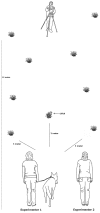Social learning from humans or conspecifics: differences and similarities between wolves and dogs
- PMID: 24363648
- PMCID: PMC3849518
- DOI: 10.3389/fpsyg.2013.00868
Social learning from humans or conspecifics: differences and similarities between wolves and dogs
Abstract
Most domestication hypotheses propose that dogs have been selected for enhanced communication and interactions with humans, including learning socially from human demonstrators. However, to what extent these skills are newly derived and to what extent they originate from wolf-wolf interactions is unclear. In order to test for the possible origins of dog social cognition, we need to compare the interactions of wolves and dogs with humans and with conspecifics. Here, we tested identically raised and kept juvenile wolves and dogs in a social learning task with human and conspecific demonstrators. Using a local enhancement task, we found that both wolves and dogs benefitted from a demonstration independent of the demonstrator species in comparison to a control, no demonstration condition. Interestingly, if the demonstrator only pretended to hide food at the target location, wolves and dogs reacted differently: while dogs differentiated between this without-food and with-food demonstration independent of the demonstrator species, wolves only did so in case of human demonstrators. We attribute this finding to wolves being more attentive toward behavioral details of the conspecific models than the dogs: although the demonstrator dogs were trained to execute the demonstration, they disliked the food reward, which might have decreased the interest of the wolves in finding the food reward. Overall, these results suggest that dogs but also wolves can use information provided by both human and conspecific demonstrators in a local enhancement task. Therefore we suggest that a more fine-scale analysis of dog and wolf social learning is needed to determine the effects of domestication.
Keywords: conspecific demonstrator; dog; domestication; human demonstrator; local enhancement; wolf.
Figures






Similar articles
-
Tracking the evolutionary origins of dog-human cooperation: the "Canine Cooperation Hypothesis".Front Psychol. 2015 Jan 15;5:1582. doi: 10.3389/fpsyg.2014.01582. eCollection 2014. Front Psychol. 2015. PMID: 25642203 Free PMC article. Review.
-
Wolves are better imitators of conspecifics than dogs.PLoS One. 2014 Jan 29;9(1):e86559. doi: 10.1371/journal.pone.0086559. eCollection 2014. PLoS One. 2014. PMID: 24489744 Free PMC article.
-
Importance of a species' socioecology: Wolves outperform dogs in a conspecific cooperation task.Proc Natl Acad Sci U S A. 2017 Oct 31;114(44):11793-11798. doi: 10.1073/pnas.1709027114. Epub 2017 Oct 16. Proc Natl Acad Sci U S A. 2017. PMID: 29078337 Free PMC article.
-
Comparing wolves and dogs: current status and implications for human 'self-domestication'.Trends Cogn Sci. 2022 Apr;26(4):337-349. doi: 10.1016/j.tics.2022.01.003. Epub 2022 Feb 7. Trends Cogn Sci. 2022. PMID: 35294857 Review.
-
Similar behavioral but different endocrine responses to conspecific interactions in hand-raised wolves and dogs.iScience. 2023 Jan 14;26(2):105978. doi: 10.1016/j.isci.2023.105978. eCollection 2023 Feb 17. iScience. 2023. PMID: 36756369 Free PMC article.
Cited by
-
Current perspectives on attachment and bonding in the dog-human dyad.Psychol Res Behav Manag. 2015 Feb 24;8:71-9. doi: 10.2147/PRBM.S74972. eCollection 2015. Psychol Res Behav Manag. 2015. PMID: 25750549 Free PMC article. Review.
-
Difference in quantity discrimination in dogs and wolves.Front Psychol. 2014 Nov 18;5:1299. doi: 10.3389/fpsyg.2014.01299. eCollection 2014. Front Psychol. 2014. PMID: 25477834 Free PMC article.
-
Training Reduces Stress in Human-Socialised Wolves to the Same Degree as in Dogs.PLoS One. 2016 Sep 9;11(9):e0162389. doi: 10.1371/journal.pone.0162389. eCollection 2016. PLoS One. 2016. PMID: 27611784 Free PMC article.
-
Spontaneous action matching in dog puppies, kittens and wolf pups.Sci Rep. 2023 Feb 16;13(1):2094. doi: 10.1038/s41598-023-28959-5. Sci Rep. 2023. PMID: 36797322 Free PMC article.
-
Differences in persistence between dogs and wolves in an unsolvable task in the absence of humans.PeerJ. 2018 Nov 27;6:e5944. doi: 10.7717/peerj.5944. eCollection 2018. PeerJ. 2018. PMID: 30515358 Free PMC article.
References
-
- Asa C. S., Mech D. (1995). “A review of the sensory organs in wolves and their importance to life history,” in Ecology and Conservation of Wolves in a Changing World eds. Carbyn L. D., Fritts S. H., Seip D. R. (Edmonton: Canadian Circumpolar Institute; ) 287–291.
-
- Boitani L., Ciucci P. (1995). Comparative social ecology of feral dogs and wolves. Ethol. Ecol. Evol. 7 49–72. 10.1080/08927014.1995.9522969 - DOI
-
- Bonanni R., Cafazzo S., Valsecchi P., Natoli E. (2010a). Effect of group size, dominance rank and social bonding on leadership behaviour in free-ranging dogs. Anim. Behav. 79 981–991. 10.1016/j.anbehav.2010.02.021 - DOI
-
- Bonanni R., Valsecchi P., Natoli E. (2010b). Pattern of individual participation and cheating in conflicts between groups of free-ranging dogs. Anim. Behav. 79 957–968. 10.1016/j.anbehav.2010.01.016 - DOI
-
- Butler J. R. A., Du Toit J. T., Bingham J. (2004). Free-ranging domestic dogs (Canis familiaris) as predators and prey in rural Zimbabwe: threats of competition and disease to large wild carnivores. Biol. Conserv. 115 369–378. 10.1016/S0006-3207(03)00152-6 - DOI
Grants and funding
LinkOut - more resources
Full Text Sources
Other Literature Sources

